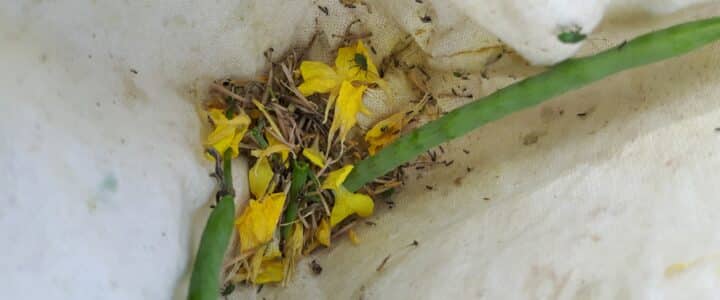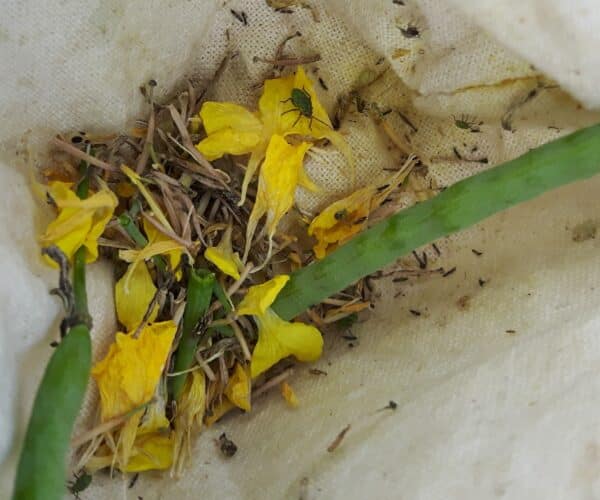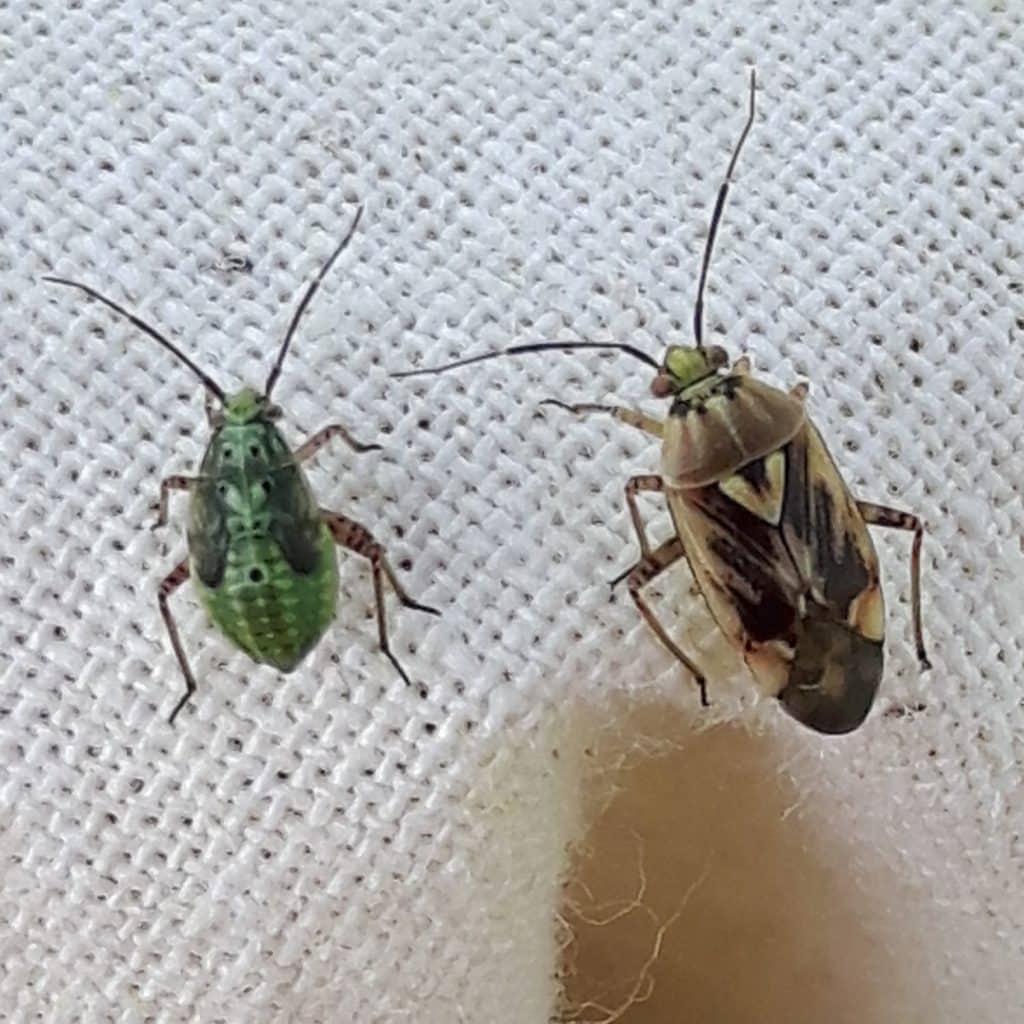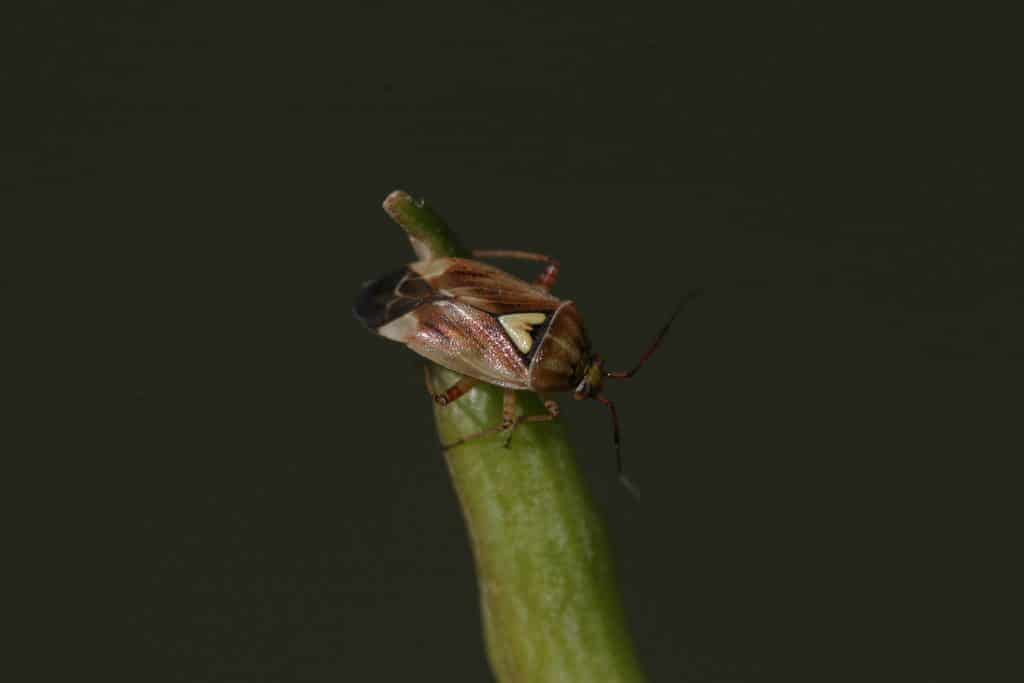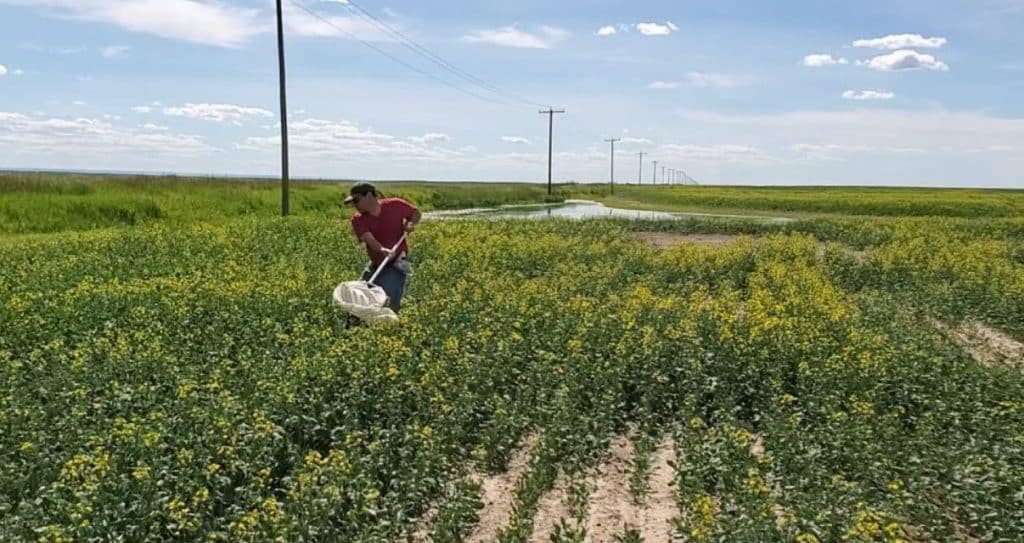The lygus bug’s piercing and sucking mouthparts allow it to feed on canola crops, but the proper management of lygus requires several considerations. First, the growth stage of the canola crop and the stage of lygus bug development both need to be accounted for when scouting for the insect. Then, pending the majority of the crop being at the early pod stage, and the lygus bugs are at the late (ex. fourth and fifth) instar or adult stage, the new economic threshold should be used to make a decision about a potential insecticide application at the early to mid-pod stage (considering pollinators and beneficial insects if an application is required). Since the thresholds have changed over the last few decades as research has provided new insights into the complexity of this insect, growers and agronomists should ensure they are using the current threshold of 20-30 lygus bugs per 10 sweeps, when using proper sampling techniques.
Accurate lygus bug sampling
In 1994, Wise and Lamb reported that lygus bugs were a newly recognized pest of canola in western Canada. They observed that lygus bugs feed on the growing points of canola plants and can cause damage to canola particularly when they attack pods and feed directly on developing seeds. The damage is usually invisible to the growers, but may result in a lower than expected yield. Although there is no doubt that lygus bugs can be damaging to canola, it has been difficult to estimate how many lygus bugs it takes to cause economic losses.
Their Estimating the abundance of lygus in canola fields project in 1994-1995 resulted in the development of an efficient sweep sample method that allows producers to efficiently assess the risk of lygus damage and minimize yield loss and control costs, resulting in yield savings of up to about 20 per cent in some fields, at the time. This method involves 12 twenty-sweep samples (or less) per field, taking no more than 30-45 minutes to complete. Further details on this area available on the project page.
Apply this research on your farm
- Use a threshold of 20-30 late instar or adult lygus bugs per 10 sweeps in canola fields at the early to mid-pod stage.
- Below 10 lygus per 10 sweeps may even stimulate canola yield.
- See Canola Encyclopedia’s lygus bug chapter
- Read Canola Watch’s lygus fundamentals article
Feeding impact on canola yields
Knowing that lygus bugs can cause damage to canola, but understanding that canola has the ability to compensate for herbivore damage, Jones’ research team completed a study which asked: Does canola compensate for lygus bug damage?
To address this, they studied plant architecture, seed yield and other vegetative and reproductive attributes potentially involved in compensation, in two experiments manipulating density and duration of infestation of lygus bugs during the bud through bloom period. The results showed that:
- Lygus feeding (during the bud through bloom period) actually induced defensive responses that were agronomically positive. No yield losses were reported and some yield increases occurred as their feeding benefits canola plants through the release of apical dominance.
- Bud “blast” was not a useful indicator of potential yield, since losses in buds and pods occurred both when yields were improved and when no changes in yield could be detected. Therefore, insecticidal control of lygus at early growth stages in canola is not recommended.
Therefore, where growing conditions allow compensation for bud damage to occur, early-season populations of lygus bugs feeding in canola during bud through flowering stages were found to not pose a threat to yield (and can even benefit yield).
Lygus interactions with CSPW
Lygus bugs and cabbage seedpod weevils (CSPW) are serious insect pests of canola in southern Alberta, so a plot insecticide trial was conducted in 2000 and 2001 as part of the Management of lygus bugs and cabbage seedpod weevils in canola project. Results from the study showed:
- A single application at the early pod stage was as effective as multiple applications to protect yields and control of lygus bugs but the single application was not adequate at the bud stage.
- Therefore, a single insecticide application at the early pod stage (not the bud stage) is recommended to protect yields and control of lygus bugs.
- That substantial canola yield can be lost when densities of lygus and cabbage seedpod weevils reach two of each pest per plant.
Almost a decade later, the four-year Management of lygus bugs and seedpod weevil in canola at the farm level project (2010-2014) in Alberta investigated the best practices for managing a combination of CSPW and lygus bug as a pest complex.
Insect management recommendations based on this study include:
- Start scouting regularly for both CSPW and lygus bug at late bud (yellow buds on bolted crop).
- To conserve and protect natural enemies, do not spray fields where weevils are below threshold as an attempt to reduce pod-stage lygus bug numbers.
- The resulting benefits of predation and other factors including rainfall may contribute to control of this pest.
- Sweep for lygus bugs after a heavy rainfall before making a spraying decision.
- Make decisions based on thorough field monitoring (and not on practices on neighbouring fields or reported local and regional weather conditions).
- Tank mixing insecticide with fungicide spray in full flower is not recommended for weevils or lygus bugs and can be harmful to pollinators and natural enemies.
Read more on this topic in the Biological discoveries that inform current cabbage seedpod weevil management recommendations blog.
Lygus thresholds
Initial investigations
Cárcamo’s 2013 Improving lygus management for current canola and faba bean cultivars research suggested that the current economic threshold of one lygus per sweep at the early pod stage was too low. For Lethbridge, canola yield losses didn’t warrant control until lygus reached ~3 lygus per sweep. While the threshold was determined to be ~2 per sweep in the Lacombe region. The results from Beaverlodge were less conclusive, but a similar impact of lygus on canola was observed.
It was determined that significant economic returns could be realized by spraying when counts surpass three lygus per sweep in southern Alberta. But results indicated that in a normal year with sufficient rain (>120 mm in June and July, normal mean temperature under 20°C in July) lygus bugs at such low abundances (one /sweep) do not pose a yield risk. If spraying isn’t need, canola production costs would be reduced and there would be positive repercussions for pollinators and other natural enemies which provide beneficial ecosystem services.
Threshold validations
Building on his previous research, considering previously-supported thresholds, and the limited data on spraying at the mid-pod stage, Cárcamo carried out the Validation of lygus and other insect pest thresholds in commercial farms throughout the Prairie Provinces project. In addition to lygus, other insects such as flea beetles at the seedling stage in humid sites, cabbage seedpod weevil in southern Alberta, diamondback moth which also require monitoring and potential control actions, were considered in this research.
The key findings and subsequent recommendations that came out of this work, included:
- Lygus threshold recommendation – Despite large variability at many levels (within a field, between fields and years), less than two lygus per sweep at early pod in canola fields generally did not reduce yield (with below one lygus per sweep actually increasing some yields), so there is no need to spray at these levels. The threshold derived from a previous cage study of 20-30 lygus per 10 sweeps was validated and is recommended for commercial canola crops.
- Since current canola cultivars appear to tolerate lygus damage better than older cultivars, reducing this threshold as prices of canola increase is not recommended.
- Following this threshold can save production costs and protect beneficial insects.
- Species, population and distribution: Interestingly, lygus bugs weren’t above thresholds in most regions of the Prairies (Manitoba, Saskatchewan and northern Alberta) in the 2016-2019 field studies conducted within this project.
- The pest risk from lygus was mainly reported in a narrow corridor between Edmonton and Lethbridge towards the foothills.
- The main species here was Lygus keltoni, with L. lineolaris becoming as prevalent in the more northern portion of this corridor.
- New cultivars in the southern portion of this corridor may be less susceptible to lygus damage than older cultivars, as there were fewer significant yield losses than a related 2010-2013 study (using older cultivars).
- The pest risk from lygus was mainly reported in a narrow corridor between Edmonton and Lethbridge towards the foothills.
- Landscape factors impacted lygus numbers:
- The lygus pest abundance may have been higher in regions of southern Alberta because this area has fewer canola fields and the lygus may have concentrated in those limited number of canola fields.
- This could explain why lygus are less of a problem in the Peace Region area if they are diluted in the vast canola acreages of neighboring fields.
- Previous cropping history had no effect on lygus abundance, which is not surprising given the high dispersal ability of these bugs.
- The lygus pest abundance may have been higher in regions of southern Alberta because this area has fewer canola fields and the lygus may have concentrated in those limited number of canola fields.
Lygus resources for growers and agronomists
Jennifer Otani, Pest Management Biologist, AAFC, Beaverlodge, AB, showcases the roster of natural enemies that attack lygus nymphs in the canola canopy.
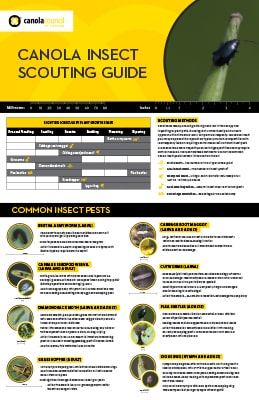
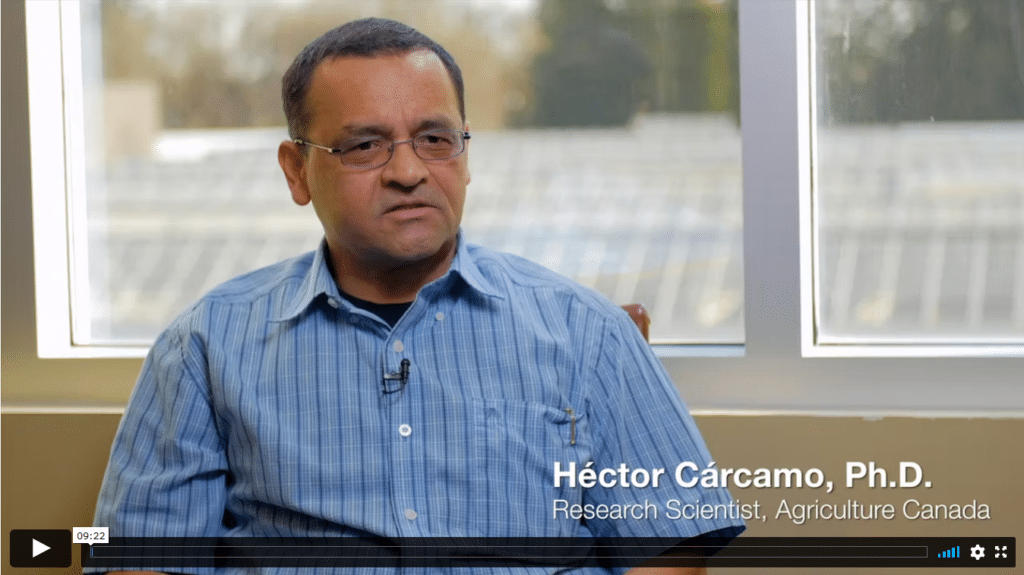
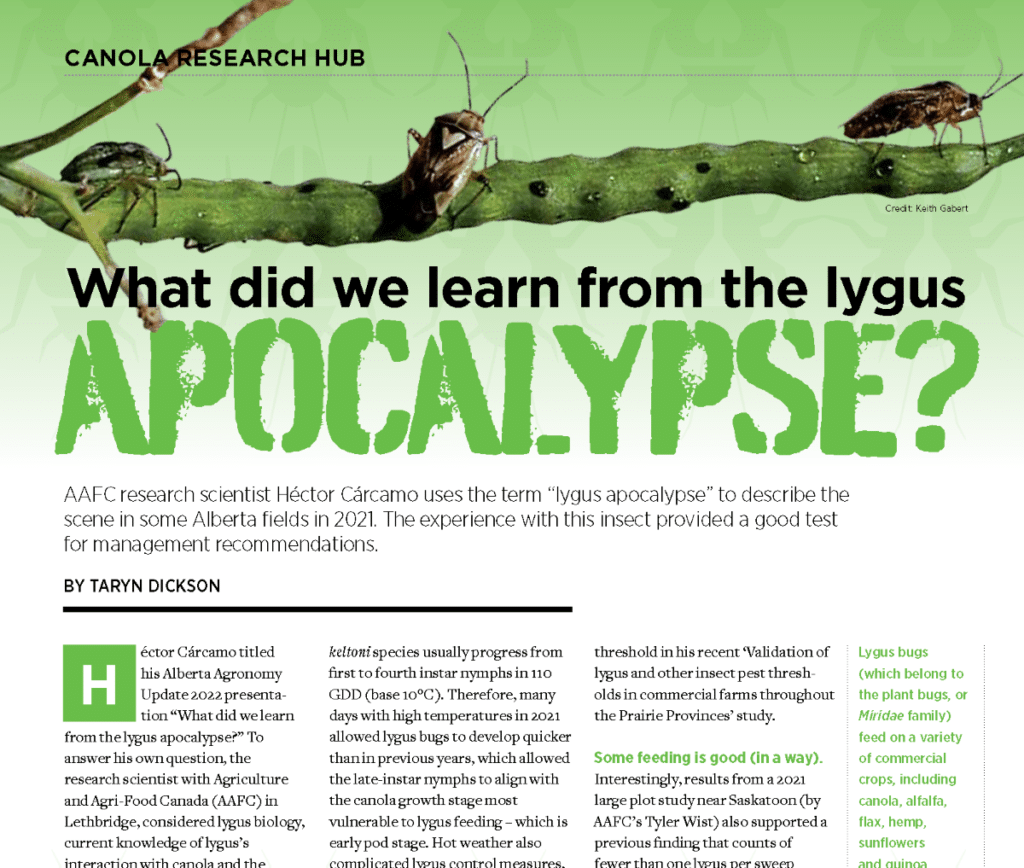

Additional lygus bug research
Earlier completed lygus bug research is available from SaskCanola:
- Assessing genetic diversity of lygus pest species in crop and non-crop habitats
- Identification of pest population of lygus species and their parasites in canola
In-progress lygus bug research is available from Alberta Canola:
Published July 26, 2022


